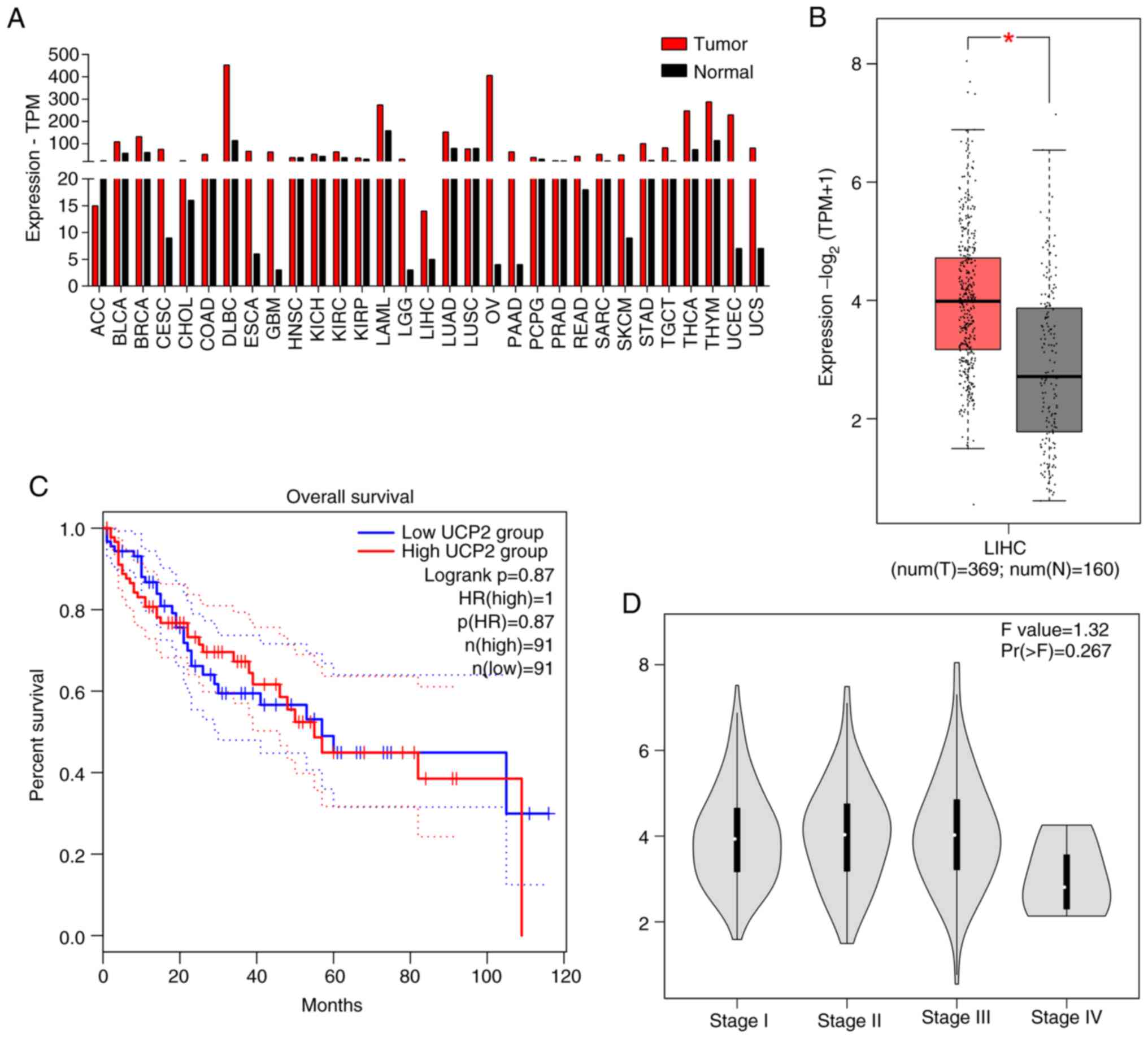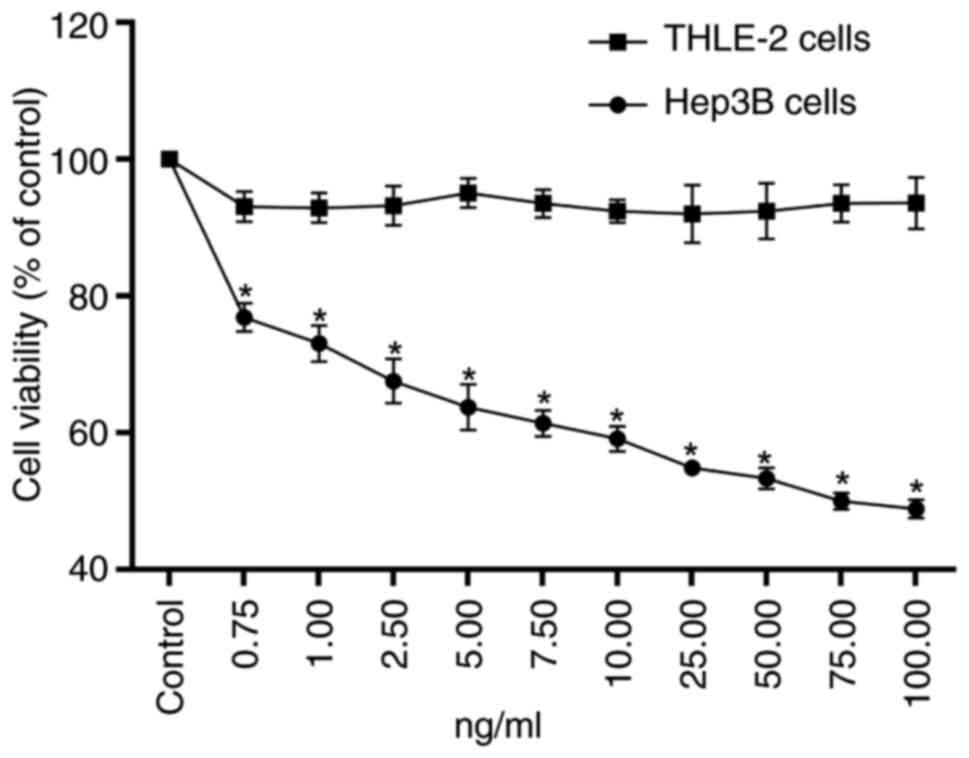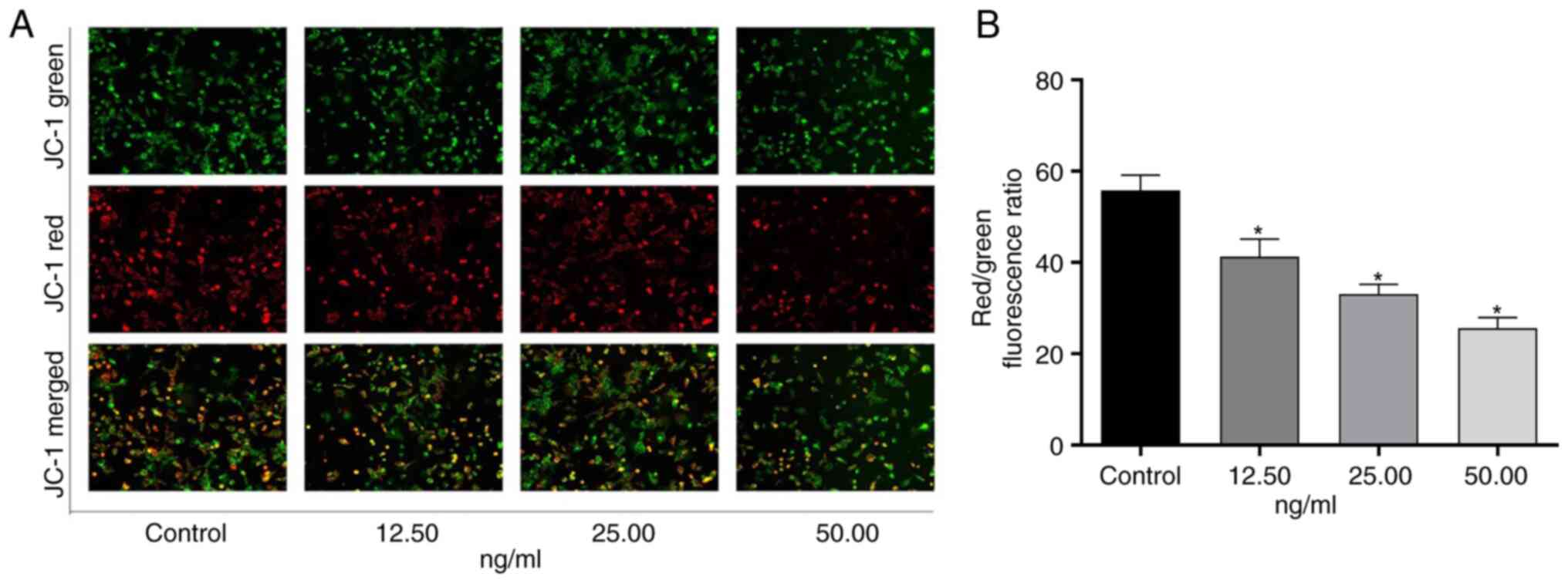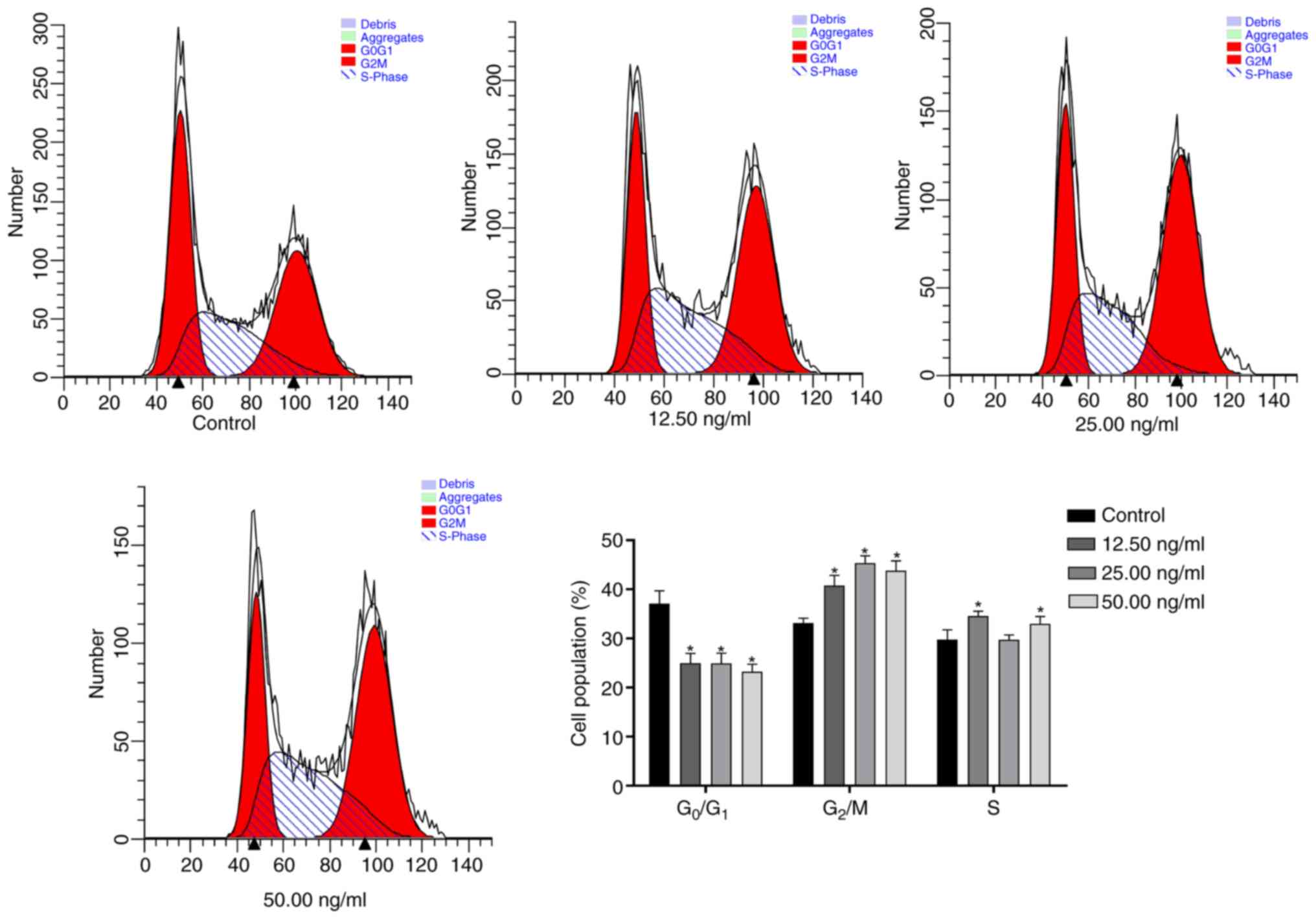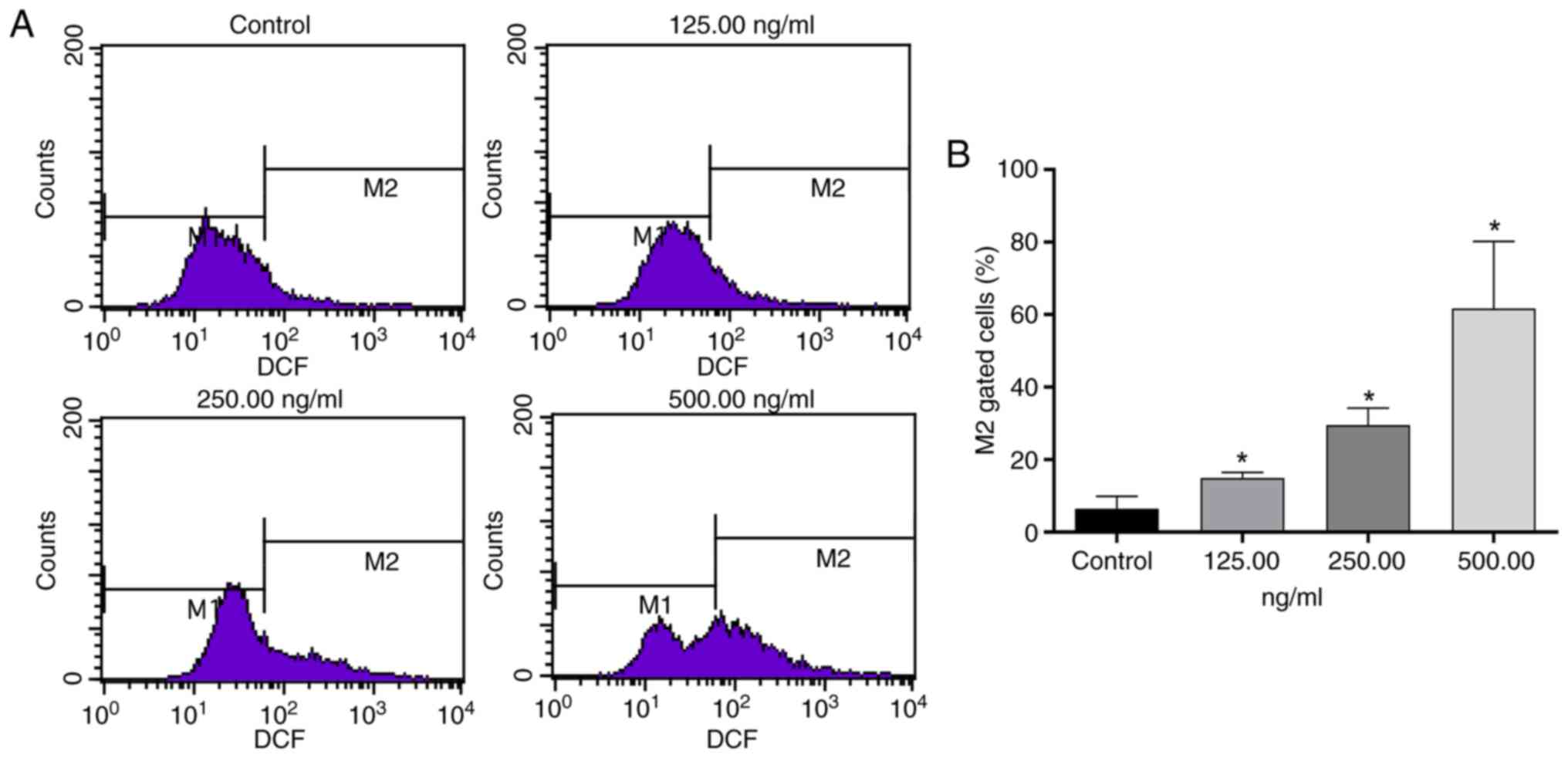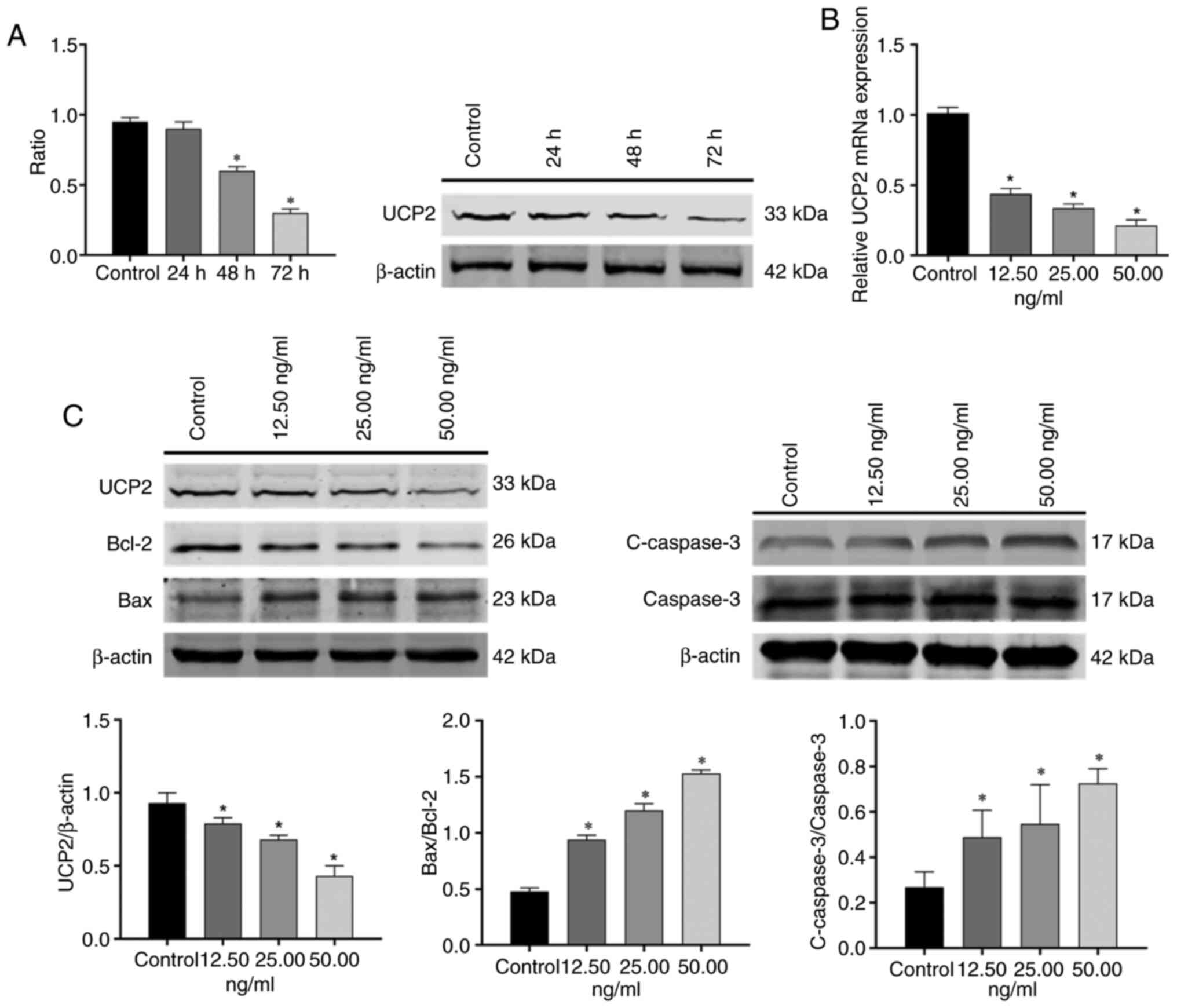|
1
|
Han B, Zheng R, Zeng H, Wang S, Sun K,
Chen R, Li L, Wei W and He J: Cancer incidence and mortality in
China, 2022. J Natl Cancer Cent. 4:47–53. 2024. View Article : Google Scholar : PubMed/NCBI
|
|
2
|
Wang X, Meng F and Mao J: Progress of
natural sesquiterpenoids in the treatment of hepatocellular
carcinoma. Front Oncol. 14:14452222024. View Article : Google Scholar : PubMed/NCBI
|
|
3
|
Wang B, Hao X, Yan J, Li X, Zhao M and Han
T: A bibliometric analysis of immune-related adverse events in
cancer patients and a meta-analysis of immune-related adverse
events in patients with hepatocellular carcinoma. J Transl Int Med.
12:225–243. 2024.PubMed/NCBI
|
|
4
|
Hadkar VM, Mohanty C and Selvaraj CI:
Biopolymeric nanocarriers in cancer therapy: Unleashing the potency
of bioactive anticancer compounds for enhancing drug delivery. RSC
Adv. 14:25149–25173. 2024. View Article : Google Scholar : PubMed/NCBI
|
|
5
|
Yao Y, Chen Y, Yao T, Li C, Li S and Wang
N: Anticancer effects of OSW-1 on colorectal cancer cells via the
ROS/NLRP3/caspase-1 pyroptosis signaling pathway. Int
Immunopharmacol. 148:1140542025. View Article : Google Scholar : PubMed/NCBI
|
|
6
|
Zhan Z, Liu Z, Zhang C, Gao H, Lai J, Chen
Y and Huang H: Anticancer effects of OSW-1 on glioma cells via
regulation of the PI3K/AKT signal pathway: A network pharmacology
approach and experimental validation in vitro and in vivo. Front
Pharmacol. 13:9671412022. View Article : Google Scholar : PubMed/NCBI
|
|
7
|
Zhan Z, Liu Z, Lai J, Zhang C, Chen Y and
Huang H: Anticancer effects and mechanisms of OSW-1 isolated from
Ornithogalum saundersiae: A review. Front Oncol.
11:7477182021. View Article : Google Scholar : PubMed/NCBI
|
|
8
|
Garcia-Prieto C, Riaz Ahmed KB, Chen Z,
Zhou Y, Hammoudi N, Kang Y, Lou C, Mei Y, Jin Z and Huang P:
Effective killing of leukemia cells by the natural product OSW-1
through disruption of cellular calcium homeostasis. J Biol Chem.
288:3240–3250. 2013. View Article : Google Scholar : PubMed/NCBI
|
|
9
|
Lee HY, Nga HT, Tian J and Yi HS:
Mitochondrial metabolic signatures in hepatocellular carcinoma.
Cells. 10:19012021. View Article : Google Scholar : PubMed/NCBI
|
|
10
|
Zeng L, Zhu L, Fu S, Li Y and Hu K:
Mitochondrial dysfunction-molecular mechanisms and potential
treatment approaches of hepatocellular carcinoma. Mol Cell Biochem.
480:2131–2142. 2025. View Article : Google Scholar : PubMed/NCBI
|
|
11
|
Szewczyk A, Jarmuszkiewicz W, Koziel A,
Sobieraj I, Nobik W, Lukasiak A, Skup A, Bednarczyk P, Drabarek B,
Dymkowska D, et al: Mitochondrial mechanisms of endothelial
dysfunction. Pharmacol Rep. 67:704–710. 2015. View Article : Google Scholar : PubMed/NCBI
|
|
12
|
Yu G, Liu J, Xu K and Dong J: Uncoupling
protein 2 mediates resistance to gemcitabine-induced apoptosis in
hepatocellular carcinoma cell lines. Biosci Rep. 35:e002312015.
View Article : Google Scholar : PubMed/NCBI
|
|
13
|
Jin J, Jin X, Qian C, Ruan Y and Jiang H:
Signaling network of OSW-1-induced apoptosis and necroptosis in
hepatocellular carcinoma. Mol Med Rep. 7:1646–1650. 2013.
View Article : Google Scholar : PubMed/NCBI
|
|
14
|
Livak KJ and Schmittgen TD: Analysis of
relative gene expression data using real-time quantitative PCR and
the 2(−Delta Delta C(T)) method. Methods. 25:402–408. 2001.
View Article : Google Scholar : PubMed/NCBI
|
|
15
|
Perelman A, Wachtel C, Cohen M, Haupt S,
Shapiro H and Tzur A: JC-1: Alternative excitation wavelengths
facilitate mitochondrial membrane potential cytometry. Cell Death
Dis. 22:e4302012. View Article : Google Scholar : PubMed/NCBI
|
|
16
|
Kubo S, Mimaki Y, Terao M, Sashida Y,
Nikaido T and Ohmoto T: Acylated cholestane glycosides from the
bulbs of Ornithogalum saundersiae. Phytochemistry.
31:3969–3973. 1992. View Article : Google Scholar
|
|
17
|
Ding X, Li Y, Li J and Yin Y: OSW-1
inhibits tumor growth and metastasis by NFATc2 on triple-negative
breast cancer. Cancer Med. 9:5558–5569. 2020. View Article : Google Scholar : PubMed/NCBI
|
|
18
|
Wang N, Li CY, Yao TF, Kang XD and Guo HS:
OSW-1 triggers necroptosis in colorectal cancer cells through the
RIPK1/RIPK3/MLKL signaling pathway facilitated by the
RIPK1-p62/SQSTM1 complex. World J Gastroenterol. 30:2155–2174.
2024. View Article : Google Scholar : PubMed/NCBI
|
|
19
|
Zhang Y, Fang F, Fan K, Zhang Y, Zhang J,
Guo H, Yu P and Ma J: Effective cytotoxic activity of OSW-1 on
colon cancer by inducing apoptosis in vitro and in vivo. Oncol Rep.
37:3509–3519. 2017. View Article : Google Scholar : PubMed/NCBI
|
|
20
|
Zhang C, Zhao Y, Yu M, Qin J, Ye B and
Wang Q: Mitochondrial dysfunction and chronic liver disease. Curr
Issues Mol Biol. 44:3156–3165. 2022. View Article : Google Scholar : PubMed/NCBI
|
|
21
|
Serviddio G, Bellanti F, Tamborra R, Rollo
T, Capitanio N, Romano AD, Sastre J, Vendemiale G and Altomare E:
Uncoupling protein-2 (UCP2) induces mitochondrial proton leak and
increases susceptibility of non-alcoholic steatohepatitis (NASH)
liver to ischaemia-reperfusion injury. Gut. 57:957–965. 2008.
View Article : Google Scholar : PubMed/NCBI
|
|
22
|
Nesci S and Rubattu SL: UCP2, a member of
the mitochondrial uncoupling proteins: An overview from
physiological to pathological roles. Biomedicines. 12:13072024.
View Article : Google Scholar : PubMed/NCBI
|
|
23
|
Yu G, Wang J, Xu K and Dong J: Dynamic
regulation of uncoupling protein 2 expression by microRNA-214 in
hepatocellular carcinoma. Biosci Rep. 36:e003352016. View Article : Google Scholar : PubMed/NCBI
|
|
24
|
Iguchi T, Kuroda M, Naito R, Watanabe T,
Matsuo Y, Yokosuka A and Mimaki Y: Cholestane glycosides from
Ornithogalum saundersiae bulbs and the induction of
apoptosis in HL-60 cells by OSW-1 through a
mitochondrial-independent signaling pathway. J Nat Med. 73:131–145.
2019. View Article : Google Scholar : PubMed/NCBI
|
|
25
|
Wu M, Huang Q, Liao M, Wu X, Xi H, Ma H,
Li S, Zhang Y and Xia Y: OSW-1 induces apoptosis and
cyto-protective autophagy, and synergizes with chemotherapy on
triple negative breast cancer metastasis. Cell Oncol (Dordr).
45:1255–1275. 2022. View Article : Google Scholar : PubMed/NCBI
|
|
26
|
Zhao P, Li X, Yang Q, Lu Y, Wang G, Yang
H, Dong J and Zhang H: Malvidin alleviates mitochondrial
dysfunction and ROS accumulation through activating AMPK-α/UCP2
axis, thereby resisting inflammation and apoptosis in SAE mice.
Front Pharmacol. 13:10388022023. View Article : Google Scholar : PubMed/NCBI
|
|
27
|
Qiao C, Wei L, Dai Q, Zhou Y, Yin Q, Li Z,
Xiao Y, Guo Q and Lu N: UCP2-related mitochondrial pathway
participates in oroxylin A-induced apoptosis in human colon cancer
cells. J Cell Physiol. 230:1054–1063. 2015. View Article : Google Scholar : PubMed/NCBI
|
|
28
|
Yu J, Shi L, Lin W, Lu B and Zhao Y: UCP2
promotes proliferation and chemoresistance through regulating the
NF-κB/β-catenin axis and mitochondrial ROS in gallbladder cancer.
Biochem Pharmacol. 172:1137452020. View Article : Google Scholar : PubMed/NCBI
|
|
29
|
El-Khoury TG, Bahr GM and Echtay KS:
Muramyl-dipeptide-induced mitochondrial proton leak in macrophages
is associated with upregulation of uncoupling protein 2 and the
production of reactive oxygen and reactive nitrogen species. FEBS
J. 278:3054–3064. 2011. View Article : Google Scholar : PubMed/NCBI
|
|
30
|
El Hoss S, Bahr GM and Echtay KS:
Lopimune-induced mitochondrial toxicity is attenuated by increased
uncoupling protein-2 level in treated mouse hepatocytes. Biochem J.
468:401–407. 2015. View Article : Google Scholar : PubMed/NCBI
|
|
31
|
Kukat A, Dogan SA, Edgar D, Mourier A,
Jacoby C, Maiti P, Mauer J, Becker C, Senft K, Wibom R, et al: Loss
of UCP2 attenuates mitochondrial dysfunction without altering ROS
production and uncoupling activity. PLoS Genet. 10:e10043852014.
View Article : Google Scholar : PubMed/NCBI
|
|
32
|
Morihara H, Yamada T, Tona Y, Akasaka M,
Okuyama H, Chatani N, Shinonome S, Ueyama A and Kuwabara K:
Anti-CTLA-4 treatment suppresses hepatocellular carcinoma growth
through Th1-mediated cell cycle arrest and apoptosis. PLoS One.
19:e03059842024. View Article : Google Scholar : PubMed/NCBI
|
|
33
|
Ni K, Li ZL, Hu ZY and Hong L: Antitumor
effect of apcin on endometrial carcinoma via p21-mediated cell
cycle arrest and apoptosis. Curr Med Sci. 44:623–632. 2024.
View Article : Google Scholar : PubMed/NCBI
|
|
34
|
Abusaliya A, Jeong SH, Bhosale PB, Kim HH,
Park MY, Kim E, Won CK, Park KI, Heo JD, Kim HW, et al: Mechanistic
action of cell cycle arrest and intrinsic apoptosis via inhibiting
Akt/mTOR and activation of p38-MAPK signaling pathways in hep3B
liver cancer cells by prunetrin-a flavonoid with therapeutic
potential. Nutrients. 15:34072023. View Article : Google Scholar : PubMed/NCBI
|
|
35
|
Liu CH, Huang ZH, Dong XY, Zhang XQ, Li
YH, Zhao G, Sun BS and Shen YN: Inhibition of uncoupling protein 2
enhances the radiosensitivity of cervical cancer cells by promoting
the production of reactive oxygen specie. Oxid Med Cell Longev.
2011:18417832021. View Article : Google Scholar : PubMed/NCBI
|
|
36
|
Hu C, Zhang X, Wei W, Zhang N, Wu H, Ma Z,
Li L, Deng W and Tang Q: Matrine attenuates oxidative stress and
cardiomyocyte apoptosis in doxorubicin-induced cardiotoxicity via
maintaining AMPKα/UCP2 pathway. Acta Pharm Sin B. 9:690–701. 2019.
View Article : Google Scholar : PubMed/NCBI
|
|
37
|
Lou J, Wang Y, Wang X and Jiang Y:
Uncoupling protein 2 regulates palmitic acid-induced hepatoma cell
autophagy. Biomed Res Int. 2014:8104012014. View Article : Google Scholar : PubMed/NCBI
|
|
38
|
Derdak Z, Garcia TA and Baffy G: Detection
of uncoupling protein-2 (UCP2) as a mitochondrial modulator of
apoptosis. Methods Mol Biol. 559:205–217. 2009. View Article : Google Scholar : PubMed/NCBI
|















